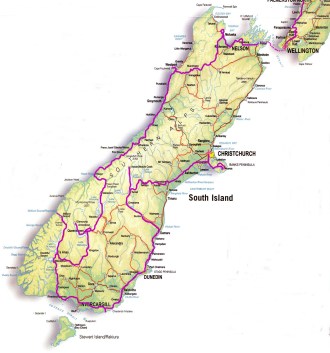Hein
and Wil website
Our trip to
New Zealand and the Cook Islands 2006
South Island
of New Zealand
On Monday
November 13 we took the Bluebridge Ferry to the South Island.
Landfall
on the S.Island is in Picton at the head of the Queen Charlotte Sound.
From Picton we made
our way via Havelock towards Nelson and on to Kaiteriteri just outside the
Abel Tasman National Park.
Kaiteriteri is situated in a delightful bay with a genuine golden sand beach
derived from the local granite.
However,
it poured when we arrived. The poor "whaka"- (canoes with outriggers)
paddlers had to put up with the sometimes torrential rains during their races.
Despite the lousy weather
we wanted to see how it looked in the sunshine so we stayed till the sun
came out.
The beach has indeed
beautiful golden sandgrains.
After we had our fill
of this beach we motored on via the lovely Motueka valley: with lots of
hops- and fruit (kiwi and other) cultivation.
This led us into the Buller Gorge via Murchison where we found a delightful
little poem by Bruce Cockburn on the wall of a local coffeeshop at the occasion
of his visit there.
The Buller
Gorge has many reminders of big earthquakes hitting this area: a reminder
of the awesome forces generated by the grinding of the Pacific Plate against
the Australian Plate, throwing up the New Zealand Alps.
At the mouth of the Buller River is Westport. Just S of there lies the Cape
Foulwind Walkway: a footpath winding along the cliffs to a colony of NZ fur
seals where at this time of the year many pups were present.
But at the start of our walk a "weka" visited us to see what we
were doing.
Further
South along the Westcoast towards Greymouth we spent some time among the "pancake
rocks" in Punakaiki.
The "pancakes"
are Oligocene limestone layers separated from one another by a stylolite (for
more info email Hein).
Furthermore there is a lot of karst and blowhole phenomena.
By clicking on any of
the photos a new window will open up with an enlargement.
Last updated
January 31, 2007
Further
south we stayed a few nights in Hokitika ("Hoki"): an artists centre
with a few good bakery/cafe's.
Wil enjoyed that very much.
As we
got farther south the weather did stay relatively attractive, and we had the
good luck of seeing Franz Josef Glacier in dry weather. But by pressing our
luck to stay a 2nd day here, the heavens opened and we did not see much beyond
the green edges of the road.
Eventually
we crossed the Alps to the east side through the Gates of Haast (with obvious
signs of tectonic activity) and dropped down to Queenstown on Lake Wakatipu.
Here we stayed a few days to explore the area a bit: on foot (Ben Lomond Trail)
and by car to the end of the lake (Glenorchy: an orgy of Lupins).
Then after a last lattee and a NZ sausage roll on the road again.
Everybody
(including our daughter Lienke) impressed on us to visit Milford Sound, especially
if and when it rained (which is most of the time): so we did!
And basically all we saw was RAIN. The boatride was cut short because of 70
knot winds which emptied the kitchen on the floor.
A neat little old goldtown
is Arrowtown on the Arrow River where Chinese goldpanners in the 1860's
tried to make here a living.
After
that wet outing we drove to the most southern point and camped in a site among
men- high Flax bushes called Curio Bay: with a beautiful deserted beach and
a Jurassic fossil forest on the foreshore AND a colony of Yellow-Eyed Pinguins.
After all this excitement
we carried on slowly but surely moving northward along the east coast of
the South island.
Via the Moeraki boulders we reached Oamaru: architecturally-exotic: it claims
to be the best preserved Victorian town with a lot of old limestone buildings
out of that period.
And we were in luck, the Santa Claus parade was on for which we extended
our visit one day.
But the most exciting and most memorable was the visit to the Blue Penguin
Colony where just before nightfall rafts of up to 40 birds at a time came
ashore to feed their chicks. Since it was almost dark, no photos of this
event, just memories.
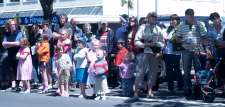
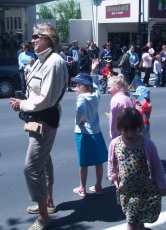
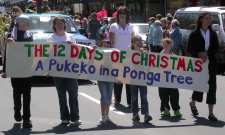
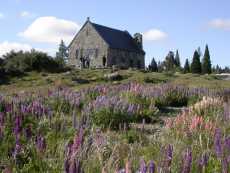

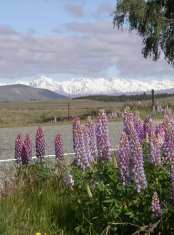
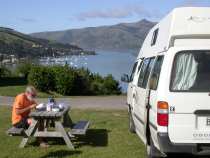
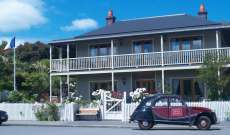

From Oamaru we made
a side trip inland, up the Waitaki Valley.
In Duntroon we found a small but really nice geological museum with beautiful
fossil forefathers of the whales found in this area.
Omarama saw us buying
a few more Merino woollen sweaters, and admiring fantastic lupin fields
on our way to Mt.Cook/Aoraki Nat. Park.
Once more we were thwarted by bad weather so we carried on to Lake Tekapo,
where the Church of the Good Shepherd still looks out over the lake and
the mountains beyond amidst some of the most fantastic lupins.
With
a few days to spare before our flight from Christchurch to Rarotonga we visited
the collapsed caldera of the Banks Peninsula , east of Christchurch.
Akaroa, a nice little village on the bay that flooded the caldera after the
collapse, was our last stay for a few days in New Zealand.
Akaroa was once almost French. The British beat the French by only a few days.
Originally the place was homesteaded by French settlers. One still finds the
French influence.
